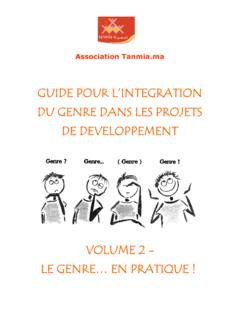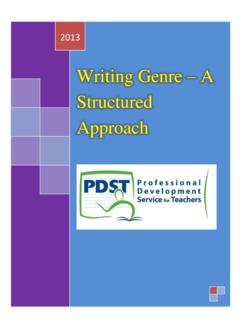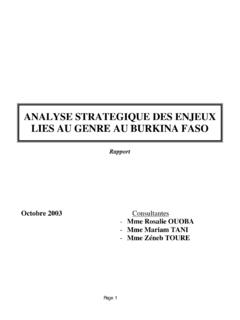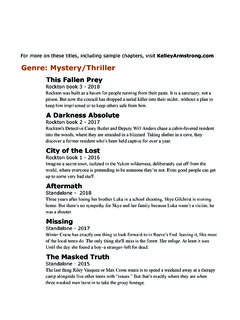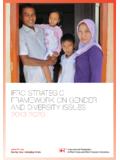Transcription of Field Level Handbook - Food and Agriculture …
1 Field LevelHandbookFood and Agriculture Organizationof the United NationsSEAGAS ocio-Economic and Gender Analysis Programme All rights reserved. Reproduction and dissemination of material in this information product for educational or other non-commercial purposes are authorized without any prior written permission from the copyright holders provided the source is fully acknowledged. Reproduction of material in this information product for resale or other commercial purposes is prohibited without written permission of the copyright holders. Applications for such permission should be addressed to the Chief, Publishing and Multimedia Service, Information Division, FAO, Viale delle Terme di Caracalla, 00100 Rome, Italy or by e-mail to FAO 2001 Prepared by Vicki Wilde in collaboration with the Socio-economic and Gender Analysis (SEAGA)
2 Programme, Gender and Development Service The designations employed and the presentation of material in this publication do not imply the expression of any opinion whatsoever on the part of the Food and Agriculture Organisation of the United Nations concerning the legal status of any country, territory, city or area or of its authorities, or concerning the delimitation of its frontiers or boundaries. TABLE OF CONTENTS 1 INTRODUCTION 1 Handbook Purpose 1 The SEAGA Approach 2 An Analytical Approach 3 An Ideological Approach 5 Summary of the SEAGA Toolkits 9 Development context toolkit 10 Livelihood analysis toolkit 10 Stakeholders' priorities for development toolkit 11 2 PREPARING FOR PARTICIPATION 13 Bringing Insiders and Outsiders Together 13 Characteristics of Rapid Appraisal 14 Preparation for Rapid Appraisal 19 Risks of Rapid Appraisal
3 27 3 WORKING IN THE Field 30 How to Be A Good Facilitator 30 How to Encourage Participation 31 How to Use Additional Field Methods 32 How to Start Well 35 4 USING Field INFORMATION 37 Analysis 37 Presentation 40 5 INTRODUCTION TO THE SEAGA TOOLKITS 44 Structure of each Toolkit 45 Structure of each Tool 46 6 THE DEVELOPMENT CONTEXT TOOLKIT 47 What? 47 How? 48 SEAGA Questions for Analysis & Summary 49 Development Context Tool 1: Village Resources Maps 49 Development Context Tool 2: Transects 53 Development Context Tool 3: Village Social Maps 56 Development Context Tool 4: Trend Lines 60 Development Context Tool 5: Venn Diagrams 64 Development Context Tool 6: Institutional Profiles 67 7 LIVELIHOOD ANALYSIS TOOLKIT 71 What?
4 71 How? 73 SEAGA Questions for Analysis & Summary 74 Livelihood Analysis Tool 1: Farming Systems Diagram 74 Livelihood Analysis Tool 2: Benefits Analysis Flow Chart 78 Livelihood Analysis Tool 3: Daily Activity Clocks 81 Livelihood Analysis Tool 4: Seasonal Calendars 83 Livelihood Analysis Tool 5: Resources Picture Cards 87 Livelihood Analysis Tool 6: Income & Expenditures Matrices 90 8 STAKEHOLDERS PRIORITIES FOR DEVELOPMENT TOOLKIT 95 What? 95 How? 97 SEAGA Questions for Analysis & Summary 98 Stakeholder's Priorities for Development Tool 1: Pairwise Ranking 98 Stakeholder's Priorities for Development Tool 2: Flow Diagram 102 Stakeholder's Priorities for Development Tool 3: Problem Analysis Chart 106 Stakeholder's Priorities for Development Tool 4:Preliminary Community Action Plan 110 Stakeholder's Priorities for Development Tool 5: Venn Diagram of Stakeholders 116 Stakeholder's Priorities for Development Tool 6: Stakeholders Conflict & Partnership Matrix 120 Stakeholder's Priorities for Development Tool 7.
5 Best Bets Action Plan 123 9 REFERENCES 128 LIST OF TABLES 1 Preparation for Rapid Rural Appraisal 19 2 Development Context Toolkit 48 3 Livelihood Analysis Toolkit 73 4 Stakeholders Priorities for Development Toolkit 97 LIST OF BOXES 1 The SEAGA Package 2 2 SEAGA Definitions 2 3 SEAGA s Three levels 4 4 Gender Roles 5 5 Key Questions 5 6 How Project Resources can be diverted to the Better Off 6 7 The 100 To 1 Cow Project Part 1 7 8 The 100 To 1 Cow Project Part 2 8 9 SEAGA Helps Us to Plan Successful Development 9 10 The Three Toolkits 9 11 The Role of the Outsider 13 12 Participatory Modelling in Ethiopia 16 13 Who do We Listen to? 16 14 SEAGA Field Study Objectives 21 15 Team Contract 22 16 RA Workplan 23 17 And don t Forget 24 18 Participation Leading to Violence 29 19 What is Your Role?
6 31 20 Knowledge and Poverty 33 21 Examples of Good and Bad Questions 34 22 Entering a Community 36 23 Validation 40 24 Outline for a Village Profile 42 25 Make it Relevant 44 26 Reaching Everybody 46 27 Field - Level Participatory Development Planning Requires 95 28 Types of Stakeholders 96 29 A Classic Battle Between the Old and the Young 99 30 Resisting Development in Colombia 116 31 Giving Voice to the Voiceless 123 SEAGA Field Handbook 11 INTRODUCTION Handbook Purpose This SEAGA Field Handbook is written for development agents who work directly with local communities in developing countries. It is intended for outsiders such as extensionists, government and non-government Field workers, and private- and public-sector development consultants, and for insiders such as community organisers and leaders of local groups and institutions.
7 The purpose of this Handbook is to support participatory development planning at the community Level . Using the tools provided in this Handbook will help outsiders and insiders to work together to: Identify key development patterns, Understand the livelihood strategies of different people, and Build consensus about development priorities and action plans. This SEAGA Field Handbook incorporates ideas and methods from people of all regions of the world who share a commitment to participatory development. It is based on actual experiences in Agriculture , forestry and fisheries, but can be used by those working in all sectors of rural development. While building on earlier learnings, there are three things that are different about this Handbook .
8 First, explicit attention is given to the linkages among economic, environmental, social and institutional patterns that together constitute the development context. Both opportunities and constraints for development are identified. Second, understanding gender, wealth, ethnicity, caste and other social differences in communities is considered fundamental to understanding livelihood strategies and development priorities. The poor and marginalised are ensured a voice. And third, this Handbook provides toolkits specifically designed to support a participatory process that first, focuses on an analysis of the current situation, and second, focuses on planning for the future.
9 The toolkits consist of a number of rapid rural and participatory rural appraisal tools, but include also a series of SEAGA Questions to facilitate and deepen analysis. This SEAGA Field Handbook is written in recognition that those of us who work directly with village women and men have a great responsibility. As outsiders who enjoy a certain degree of power, privilege and security, we must remember that many insiders do not. Indeed, many villagers walk a thin line between poverty and destitution. This is especially true for those who lack access to key resources because of their gender, ethnicity or caste. The only sure way to avoid mistakes, or negative impacts, is through a participatory process in which rural women and men clarify their needs and resources, constraints and opportunities.
10 But for development efforts to be truly beneficial in the long run, people's needs and priorities must also be considered in light of the total development context, many factors of which stem from outside the community. And this is where you come in -- as the bridge. 2 The SEAGA Approach SEAGA stands for Socio-economic and Gender Analysis. It is an approach to development based on an analysis of socio-economic patterns and participatory identification of women s and men s priorities. The objective of the SEAGA approach is to close the gaps between what people need and what development delivers. By putting socio-economic analysis and gender analysis together, SEAGA helps us to learn about community dynamics, including the linkages among social, economic and environmental patterns.










